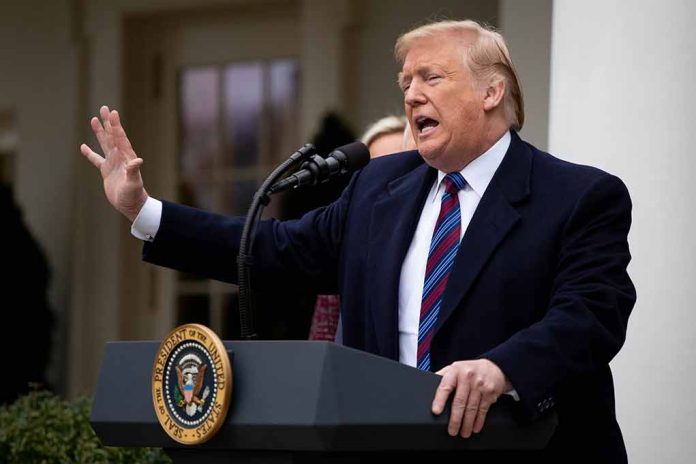
U.S. military troops can now detain illegal immigrants crossing the southern border as the Trump administration transfers vast stretches of federal land to Army control, dramatically expanding military authority in border security operations.
Key Takeaways
- The U.S. military has been authorized to detain illegal immigrants on a 60-foot-wide strip of land along the New Mexico border that has been reclassified as part of Arizona’s Fort Huachuca.
- President Trump transferred control of approximately 110,000 acres from the Department of Interior to the Department of Defense on April 11, creating the New Mexico National Defense Area (NMNDA).
- Military personnel can now search individuals, implement crowd control measures, and assist with constructing temporary barriers until law enforcement arrives.
- Over 10,000 service members are currently deployed along the southern border with plans to expand military jurisdiction to include over 90 miles in Texas.
- Defense Department southern border operations are estimated to cost nearly $1 billion over eight months.
Military’s Expanded Role in Border Security
U.S. Northern Command (USNORTHCOM) announced that military personnel can now conduct security operations on land transferred to the Army along the southern border. The 60-foot-wide New Mexico National Defense Area is now officially part of the U.S. Army’s Fort Huachuca installation, covering portions of California, Arizona, and New Mexico. This significant shift in policy follows President Trump’s memorandum authorizing military jurisdiction over federal lands for enhanced border security operations.
Service members stationed within the NMNDA now have expanded authorities to detain trespassers, conduct searches, provide medical assistance, and implement crowd control measures. Additionally, military personnel can assist with setting up temporary barriers, signage, and fencing to deter illegal crossings. The Department of the Interior transferred nearly 110,000 acres of federal land to the Army to support Border Patrol operations for the next three years.
🇺🇸 Fox News: US military personnel in a New Mexico National Defense Area near the southern border can now temporarily detain & search illegal migrants. This shifts their role beyond traditional support, allowing detention of trespassers until law enforcement arrives. pic.twitter.com/UKLx7wA4BH
— Faytuks Network (@FaytuksNetwork) April 21, 2025
Strategic Coordination with Law Enforcement
General Gregory Guillot, USNORTHCOM commander, emphasized the coordinated approach between military and law enforcement agencies. “Through these enhanced authorities, U.S. Northern Command will ensure those who illegally trespass in the New Mexico National Defense Area are handed over to Customs and Border Protection or our other law enforcement partners,” General Guillot stated. The military’s role includes conducting enhanced detection and monitoring operations to identify border crossers.
Currently, over 10,000 service members are deployed along the southern border to support Customs and Border Protection. This marks a significant expansion of military involvement in what has traditionally been civilian law enforcement territory. The move represents a departure from longstanding limitations on military involvement in domestic policing, which have been in place to prevent militarization of police functions within U.S. borders.
Expanding Military Border Presence
White House press secretary Karoline Leavitt announced broader plans for the military’s border presence. “Last week, President Trump signed a National Security Presidential Memorandum directing federal agencies administering federal land on the border to make land available to the Defense Department in a new national defense area. … This new national defense area spans more than 170 miles across our border in New Mexico. But in the coming weeks, this administration will add more than 90 miles in the state of Texas,” said Leavitt.
The cost implications of this expanded military role are substantial. The Defense Department’s southern border operations are estimated to cost nearly $1 billion over eight months. Critics, primarily Democrats, have raised concerns about the resource burden and financial costs associated with deploying military personnel for border security functions. However, the administration has defended these measures as necessary given current migration patterns.
Additional Border Security Measures
Beyond the expanded military presence, the Trump administration is advancing other border security initiatives. This includes a recently issued waiver to expedite border wall construction in southern California, bypassing environmental laws to accelerate the construction of 2.5 miles of barrier outside San Diego. These physical barriers complement the enhanced surveillance and detention capabilities now available to military personnel.
Initial data suggests these intensified border security efforts may be having an impact. Border Patrol apprehensions of illegal immigrants have reportedly decreased significantly from March 2024 levels. As the administration continues to implement its multi-faceted approach to border security, military personnel will play an increasingly pivotal role in detecting, detaining, and deterring illegal border crossings.
Sources:
Military Given Power to Detain Immigrants on U.S.-Mexico Border
US Troops Given Authority To Detain Illegal Immigrants







